A modern day twist on an old classic infamous Jamaican dish made with coarse cornmeal, homemade saltfish, thyme, scallion, thyme, tomato and simmered in coconut milk. The most delicious fluffiest turn cornmeal you will ever taste!!
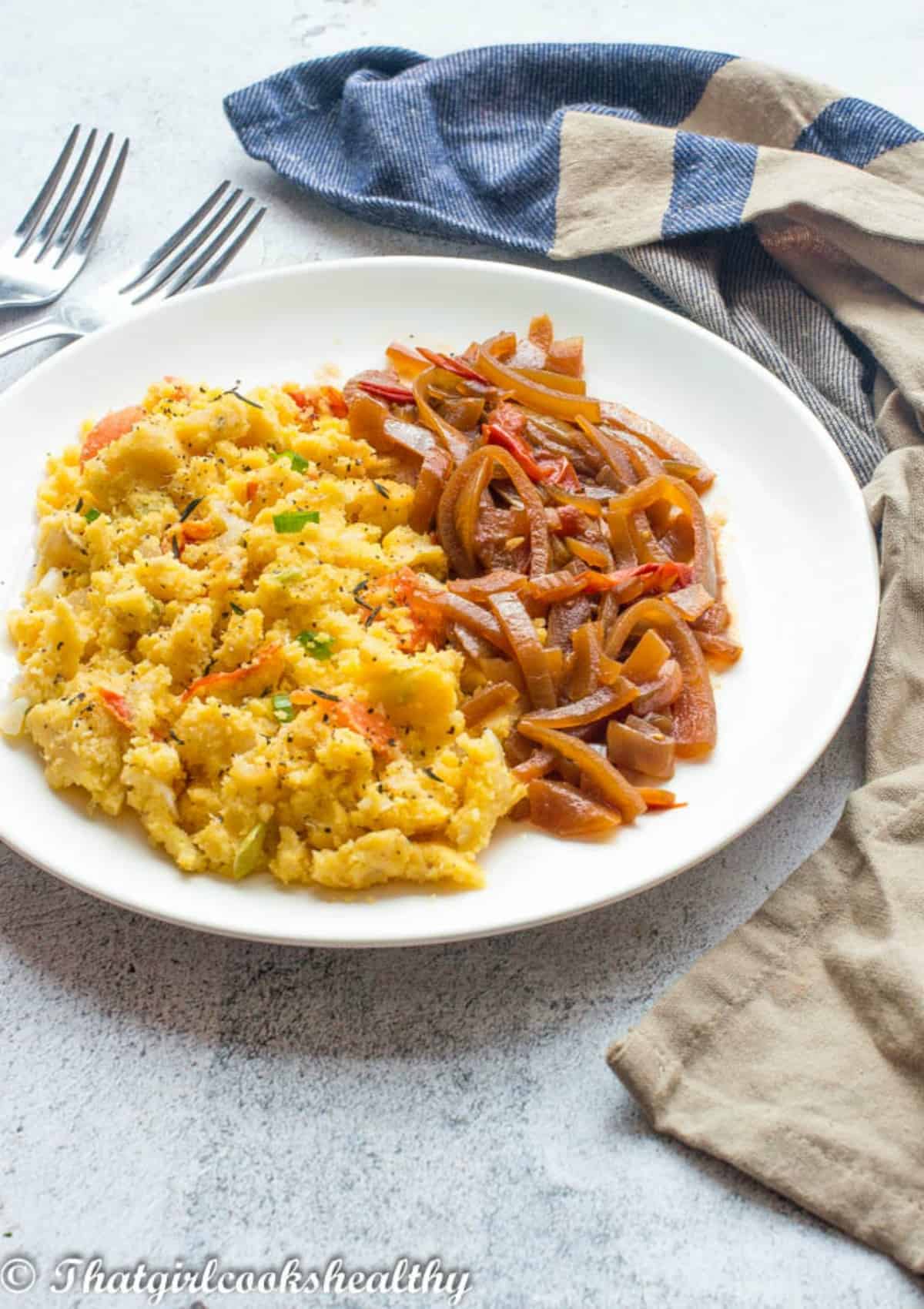
I'm so excited to share this recipe with you all. It's fairly straight forward and equally as filling too, most of the ingredients are what you will find in a typical Caribbean household. Enjoy your turn cornmeal alone, or simply as a side dish.
What is turn cornmeal
Often referred to as turned cornmeal or tun cornmeal (in Jamaican patios) is a dish made primarily from cornmeal, coconut milk, water along some herb, spices and even vegetables of your choice.
The base of the recipe - herbs, spices and vegetables are cooked then the coconut milk is added and finally the cornmeal/water is mixed together and stirred into the saucepan until the mixture thickens up.
To turn the cornmeal simply means to mix until a thick, mush texture is achieved. The cornmeal tends to be quite dense, not soft and can be scrambled especially as it cools down.
In terms of what it's served with most people eat it with steamed fish, curry chicken or an assortment of vegetables if they are vegan.

The good, the bad and the ugly
As with most cultures, there are some foods that are embraced while others are frowned upon and stigmatized.
For many Jamaicans, tun cornmeal has it's negative connotations because it is considered poor mans food as well as what's fed to the dogs.
There tends to be a divide among the people of Jamaica, those that embrace it and those who refuse to consume it.
I guess the poor man's dish comes from many generations ago where times were hard and food such as this was seen as a luxury.
My mother and grandmother raised me to eat turn cornmeal, although it wasn't made very often.
My grandmother would usually make it if she wanted something different and/or she wasn't in the mood to stay in the kitchen for too long. We would make two versions - sweet and the other being savoury.
Don't be swayed by the negative association with this dish. I can promise you, stigma aside, it's utterly delicious and extremely filling albeit it may not look very appetising on a plate.
Alternative names
There are various places within the Caribbean and throughout the world that eat this dish or similar but call it something else.
In Italy it is known as polenta, a type of mush consisting of boiled cornmeal.
In Barbados, it is known as cou cou and forms part of the national dish which is served with flying fish.
Other islands such as Trinidad and Tobago and Grenada also refer to it as cou cou (coo coo).
Haitans refer to this as mayi moulen.
While Antigua and Barbuda, Virgin Islands, St Kitts and Nevis know it as fungi. The dutch islands such as Aruba call it funchi and in certain parts of Africa it is known as Ugali or maize meal.
In all honesty you can make alot of recipes with cornmeal, for example; Cornmeal Pudding or even make Jamaican Cornmeal Porridge.
You can even omit the saltfish and serve it with Curry Chicken.
How to cook turn cornmeal
- Pour the cornmeal in a bowl/jug and mix together with the water to form a liquid paste then set aside.
- On medium heat, use a medium sized pot and add olive oil then proceed to saute the onion, scallion and garlic until soft and translucent.
- Now add the tomato, saltfish, thyme, all purpose seasoning, black pepper and continue to cook for 2 minutes.
- Pour in the coconut milk and add the dairy free butter.
- Reduce the heat to the lowest setting and let the coconut milk heat up for 2 minutes
- Slowly pour the cornmeal paste/mixture into the pot while stirring vigorously with the other hand until it starts to thicken (it should look like a milky/porridge consistency to begin with)
- Cover the pot with a lid and let it steam/cook for a total of 30 minutes, check and gently stir (3-4 turns) every 10 minutes. Around the 25 minute mark is where you want to really focus on increasing the heat to medium-high and stirring to bring the cornmeal together. Stir, fold and cut the turn cornmeal as it thickens. It should pull away from the sides of the pot with ease
- Serve accordingly. as the cornmeal cools down it separates and scrambles very easily.
Notes and tips
- I personally recommend using the coarse textured cornmeal to make this recipe.
- Make sure to follow the instructions to the TEE, especially it's your first time making the recipe
- Do not increase the heat (unless stated) or try to hasten the cooking process or you run the risk of ruining the dish.
- Make sure the heat is reduced when pouring the cornmeal mixture to avoid lumps and the cornmeal from thickening too quickly. If it thickens too fast it won't cook properly.
- The cornmeal should be dense and scrambles/breaks apart especially as it cools.
- Coarse cornmeal takes slightly longer then it's finer counterpart to cook.
- It's best to serve immediately or warm at best
- Add a splash of water if you intend to reheat first of all.
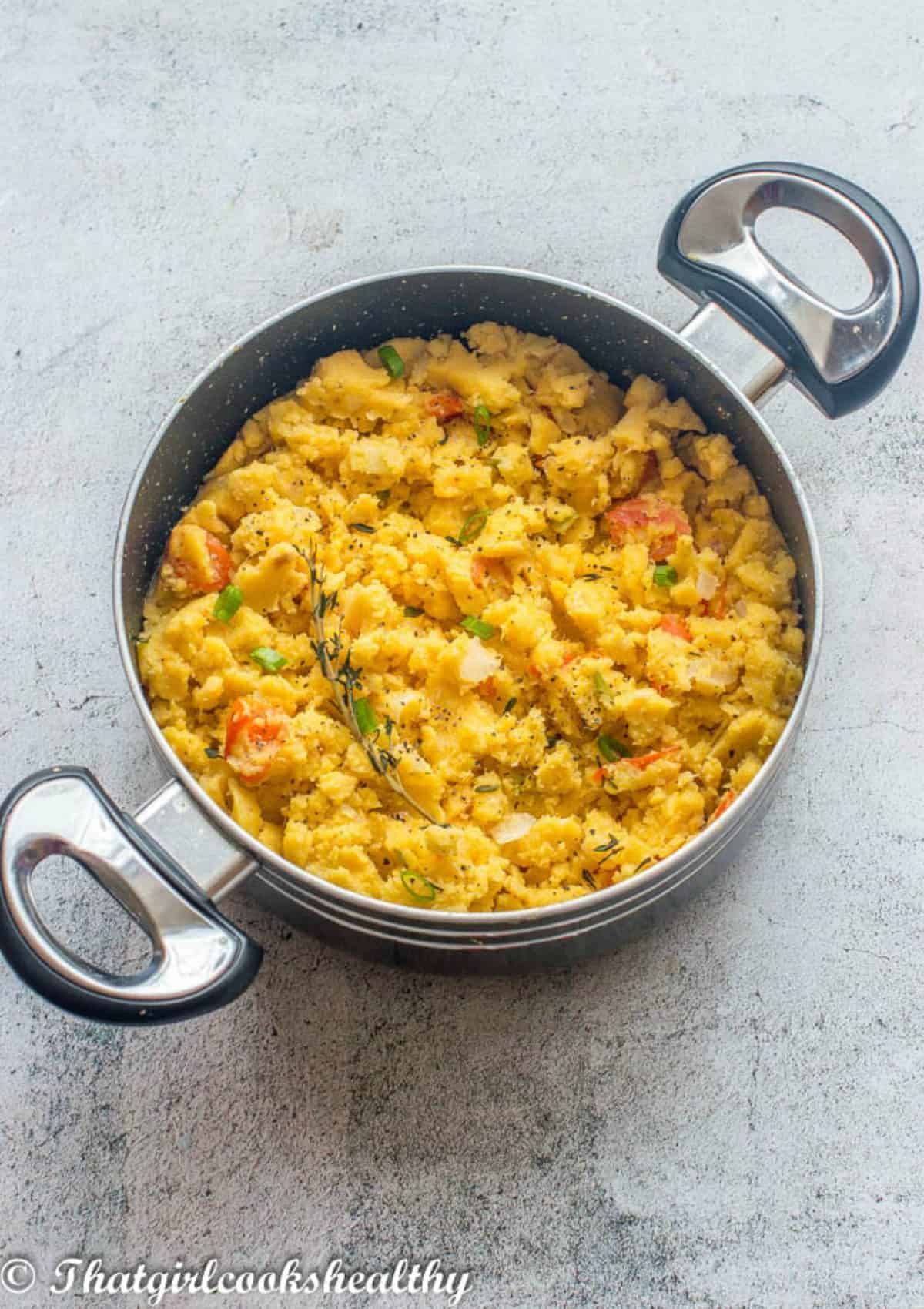
Useful Ingredients To Use In This Recipe
Other Recipes You May Like
**Don't forget to comment below and star rate if you have tried my recipes. Let's be friends and engage on Facebook and Instagram I also like to pin on Pinterest, where you can find more amazing recipes.**
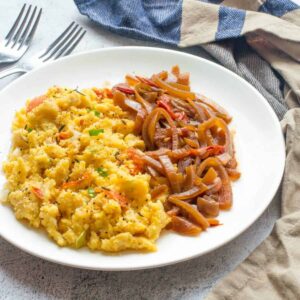
Saltfish Turn Cornmeal
Ingredients
- 2 cups of coarse cornmeal organic, if possible, 250g
- 1 can of full fat coconut milk 400ml/2 cups
- 2 cups of water 400ml
- 1 cup of cooked saltfish 90g (see post for homemade recipe)
- 1 small onion chopped
- 3 scallion chopped
- 2 garlic cloves minced
- 1 large tomato chopped
- 4 sprigs of thyme stem removed or 1/1 tablespoon dried
- 1 teaspoon black pepper
- ½ teaspoon all purpose seasoning optional, see post for recipe
- 2 tablespoon of dairy free butter
- 2 tablespoon of olive oil or coconut oil
Instructions
- Pour the cornmeal in a bowl/jug and mix together with the water to form a liquid paste then set aside.
- On medium heat, use a medium sized pot and add olive oil then proceed to saute the onion, scallion and garlic until soft and translucent.
- Now add the tomato, saltfish, thyme, all purpose seasoning, black pepper and continue cook for 2 minutes.
- Pour in the coconut milk and add the dairy free butter.
- Reduce the heat to the lowest setting and let the coconut milk heat up for 2 minutes
- Slowly pour the cornmeal paste/mixture into the pot while stirring vigorously with the other hand until it starts to thicken (it should look like a milky/porridge consistency to begin with)
- Cover the pot with a lid and let it steam/cook for a total of 30 minutes, check and gently stir (3-4 turns) every 10 minutes. Around the 25 minute mark is where you want to really focus on increasing the heat to medium-high and stirring to bring the cornmeal together. Stir, fold and cut the turn cornmeal as it thickens. It should pull away from the sides of the pot with ease
- Serve accordingly. as the cornmeal cools down it separates and scrambles very easily.
Notes
- I personally recommend using the coarse textured cornmeal to make this recipe.
- Make sure to follow the instructions to the TEE, especially it's your first time making the recipe, do not increase the heat (unless stated) or try to hasten the cooking process or you run the risk of ruining the dish.
- Make sure the heat is reduced when pouring the cornmeal mixture to avoid lumps and the cornmeal from thickening too quickly. If it thickens too fast it won't cook properly.
- Turn cornmeal should be dense and scrambles/breaks apart especially as it cools.
- Coarse cornmeal takes slightly longer then it's finer counterpart to cook.
- It's best to serve immediately or warm at best
- Add a splash of water if you intend to reheat first of all.


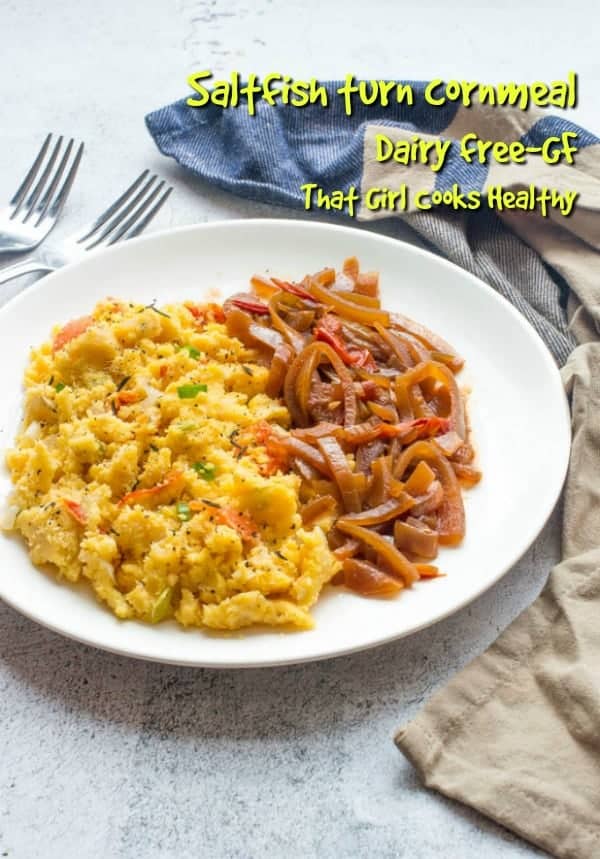
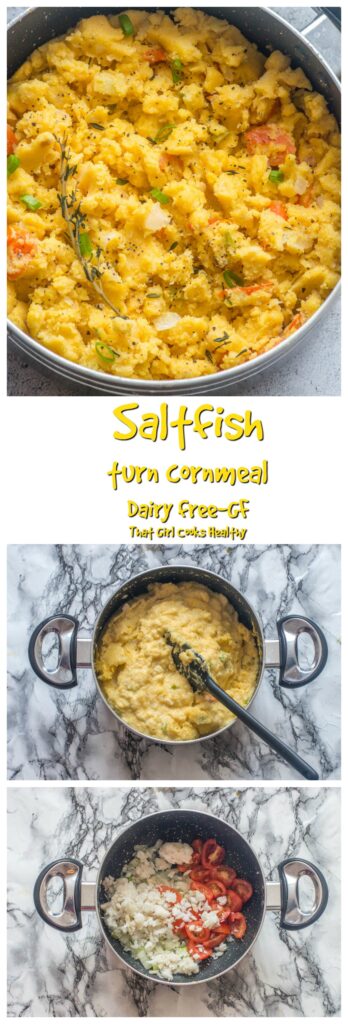
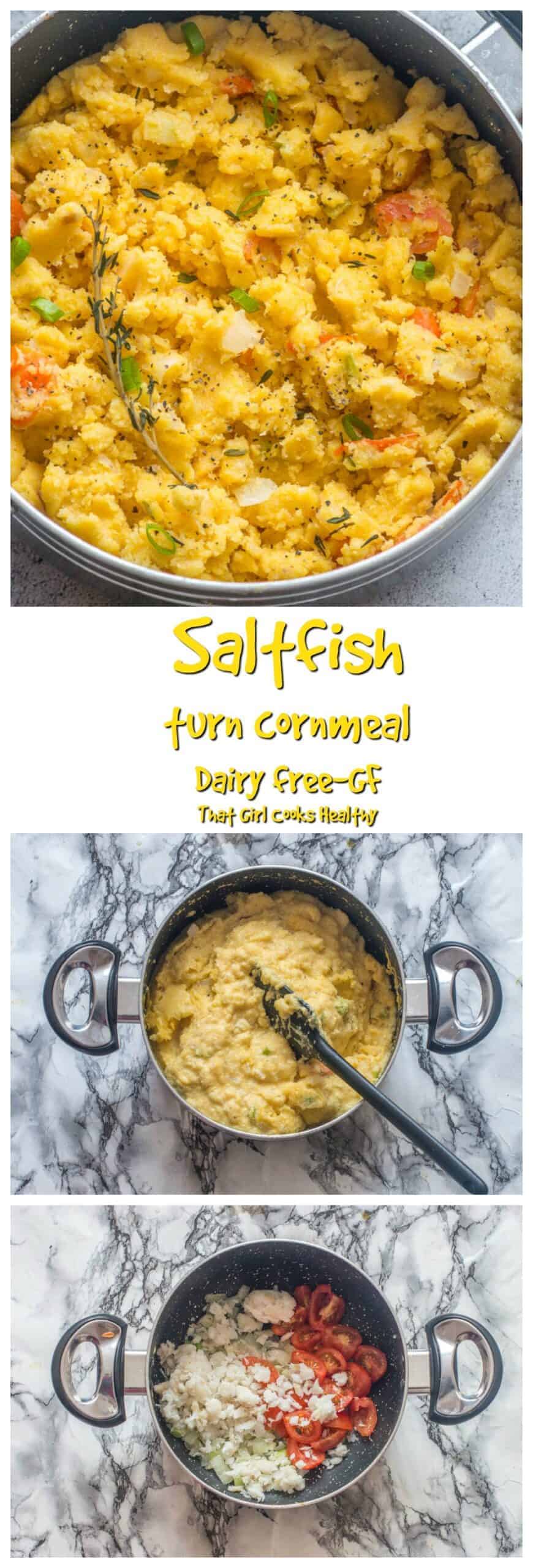
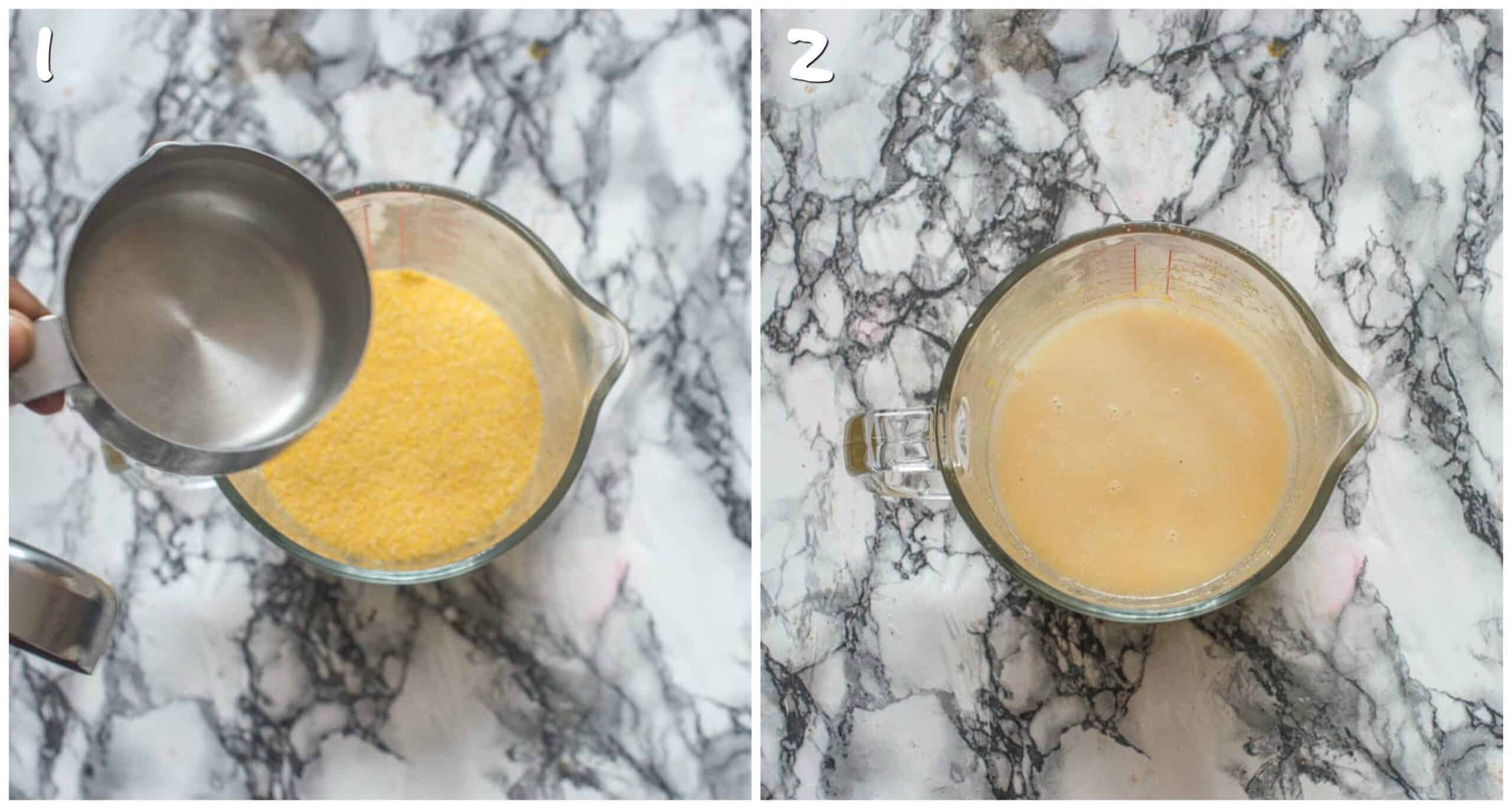
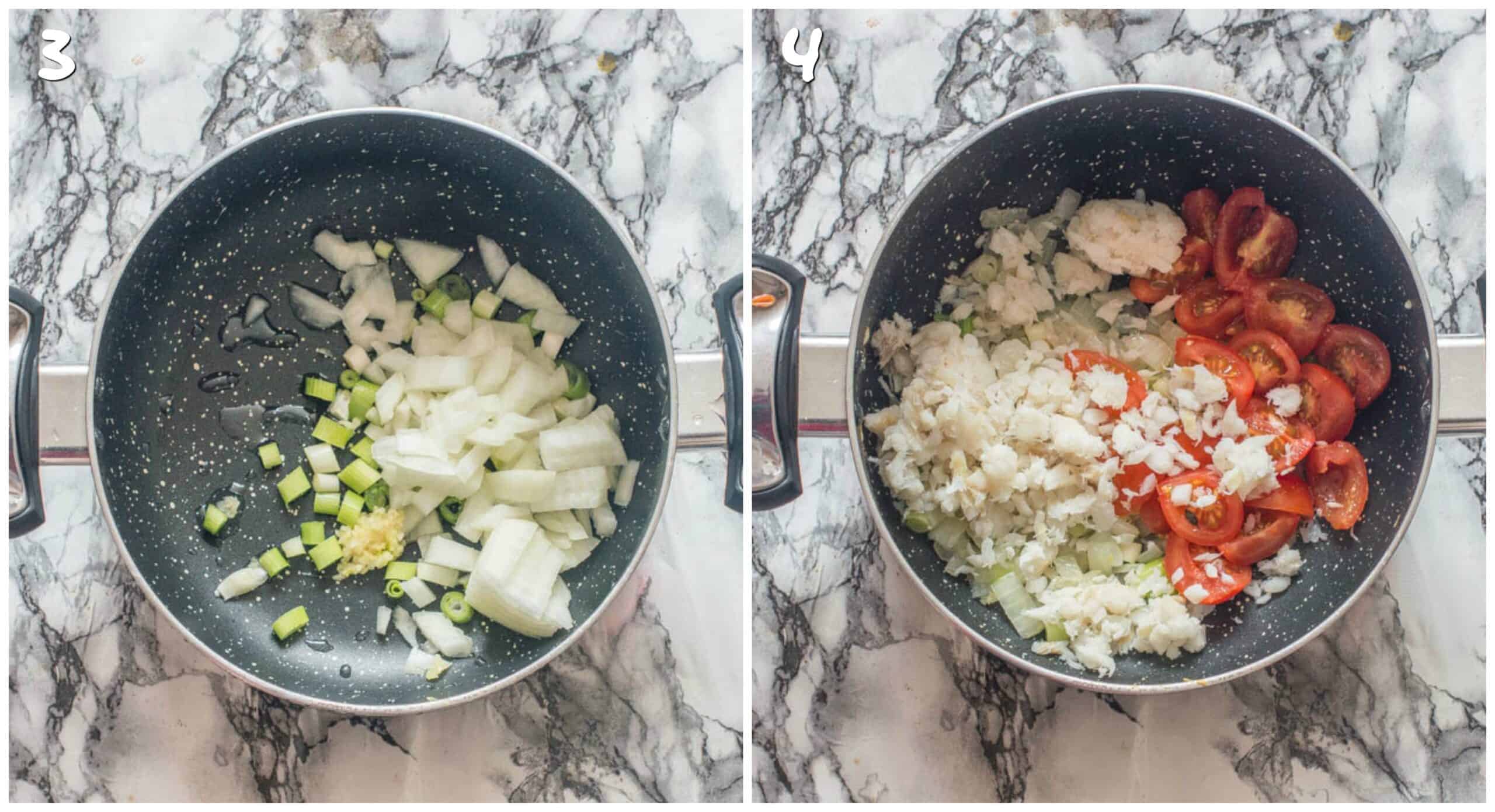
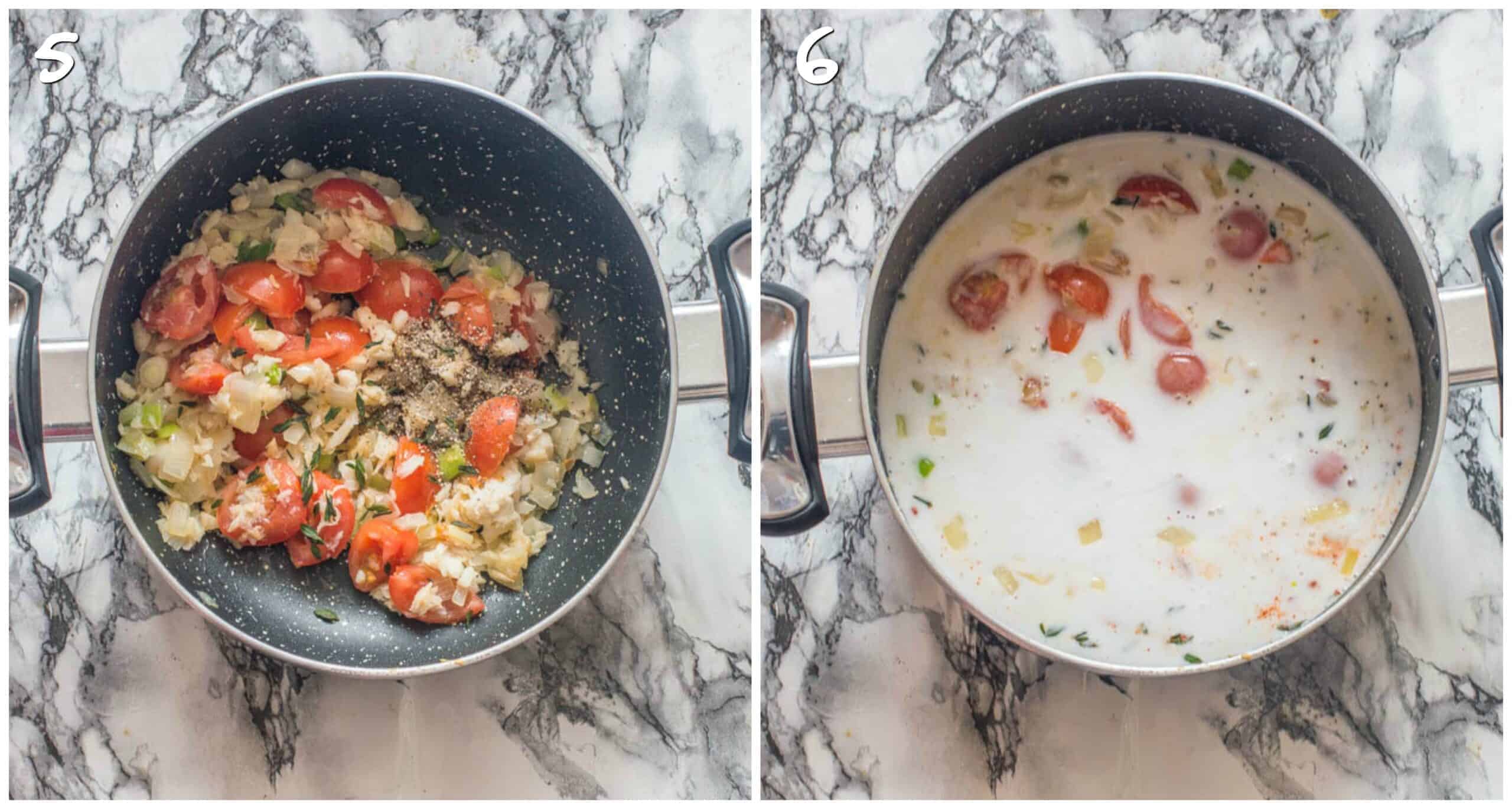
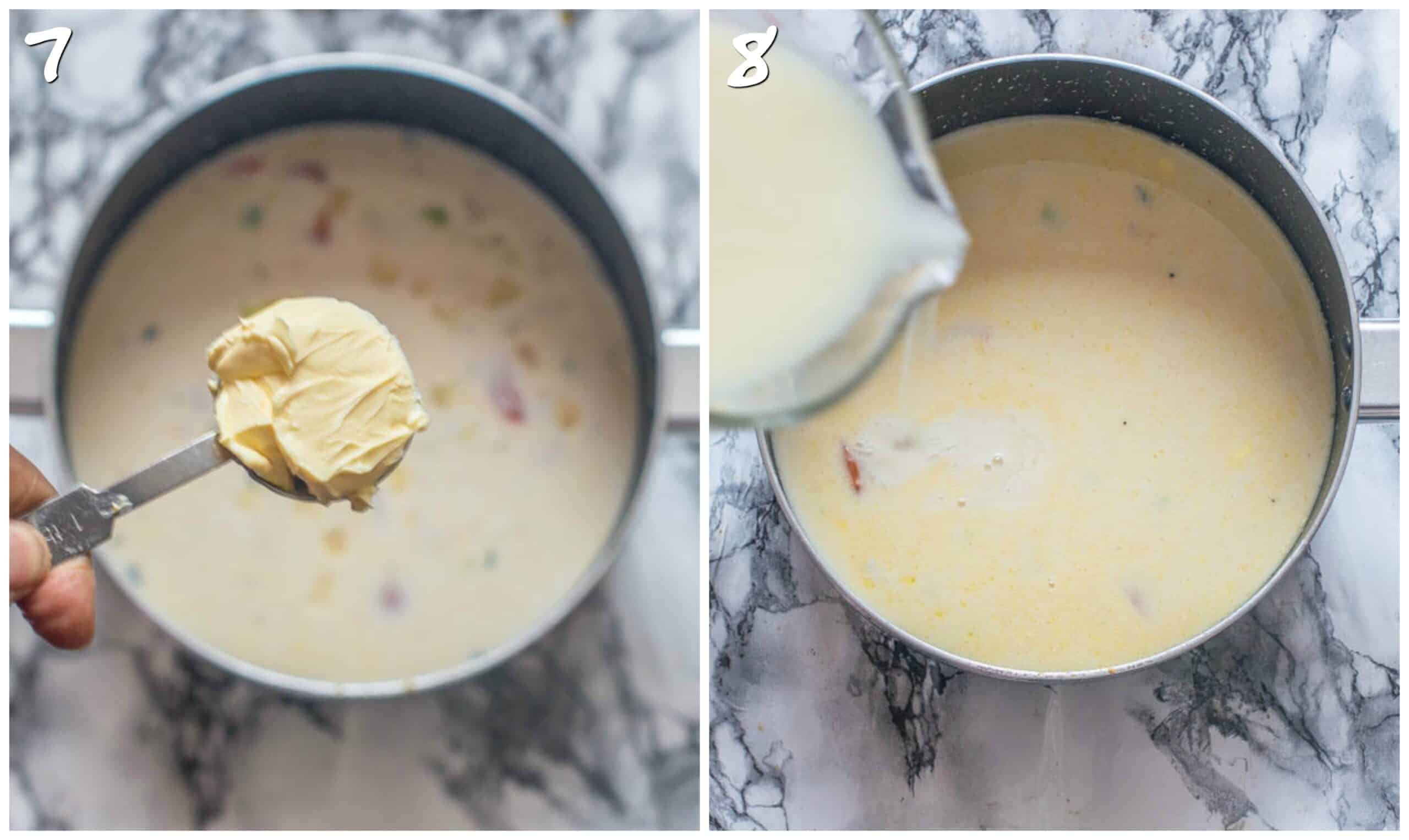
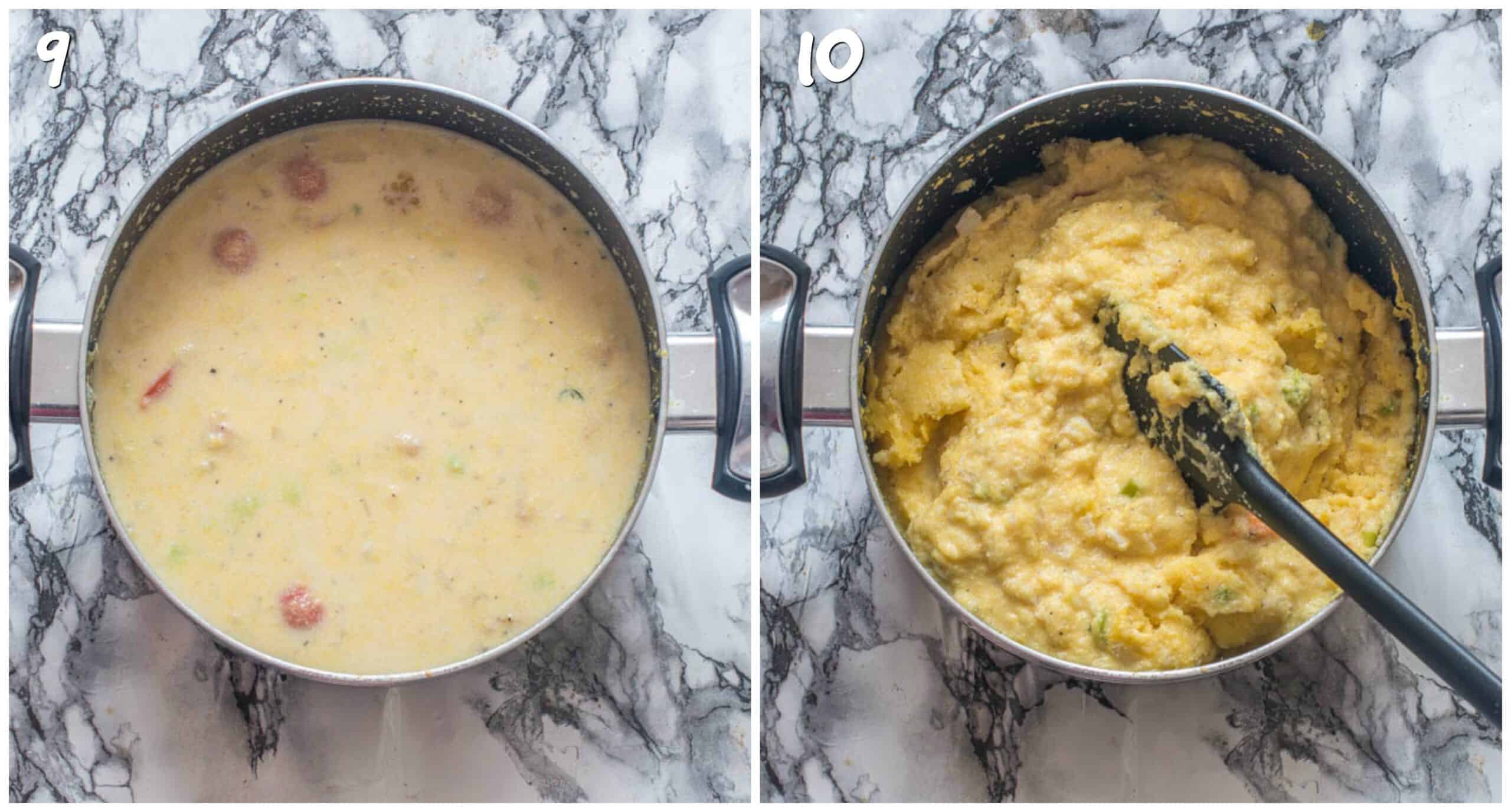

Fay
I have just come across this recipe. I'm British born of Jamaican decent and used to make this years ago. It was always my favourite, but as I say I haven't made it in over 20 years. However this recipe is so simple to follow .. before the week is done I'm going to make it! In fact I was just in Jamaica for December and my aunt did make it for the dogs. I was so happy when I went into the kitchen and saw it but when she said it wasn't for me but for the dogs ... you can't even imagine my disappointment. Hence coming across this article today is like a .....SIGN 😋
Charla
Hi Fay, yes I do HATE the stigma with turn cornmeal. I remember growing up having that same experience "tun cornmeal ah fi dawg" yet we would still eat it. I've learnt to embrace it despite the negative connotations. Go ahead and treat yourself to some, you won't be sorry! Thanks for stopping by!
Traci
I looked at a few recipes before giving it a go. Wish I had taken your advice about using a coarser texture. I used fine cornmeal first again based on other recipes, then tried the coarser texture, and that was a winner for me!
Charla
Hi Traci, no problem! You live and you learn. When there are so many recipes to choose from online, it's not always easy to know which one works best for you. I guess some people like their turn cornmeal with a smooth finish but growing up my mother and grandmother would use always use the coarser texture. Thanks for stopping by!
JeanneMichelle Betaudier
Greetings, I am so enjoying your recipes and your blog comments. I a Chrf, residing in Santa Cruz California, and of Trinidadian origin. My first experiences in Culinary most likely began with cleaning the stones from the peas(any and All) sitting at the kitchen table with my Granny. Blessed good sweet memories they. For some reason, of All of your posts that I've read so far, This was the one that pooked my pen .
I'm So happy that you take this rout with the 'SaltFish'. Been there. Actually, I got there ,ONLY after I discovered how difficult it was to source SaltFish in these parts. Even when one does find it, the price is somewhere in the AYFKM range!!! and We all know, that this is 'poor man's staple' food and should be affordable to Everyone, NOT reserved for the 'WholeFoods' folks. ...but I digress...
The other determining factor, was that my partner is an avid fisherman, and brings me tons of Fresh Cod. I feel truly blessed.
So here I am with ALL of this fresh goodness...What to do !!???
Make Stuff , ... by which I mean 'The Good Stuff 👍' So , just like you, I fixed myself to take what I had before me and kind of work backwards. So here's what I did.
Supper rice the fish in Cold Water , and drain. De bone. De worm. Depending upon how much fish I have, I use a copious amount of pink salt, lime/lemon juice( I like a mix of both for flavor), and either a bit if White Baslmic Vin. or sweet rice wine Vin or apple cider Vin. This is just my starting point. I also do not boil mine ,as I find that it makes the fish come out a bit tough and chewy, not my favorite. But if after the fish is rinced, which by the way should be after a few hours tops, 30 mins minimum. After rinsing in Cold water ,let it sit for a bit to room temp and put it in boiling water for not more than ten minutes. That's enough. I comes out fluffy, delicate, full of flavor, AND COOKED! 🙂.
I am so enjoying your recipes, and wish that we were sharing a collaborative cooking experience IRL, at some fully equipped kitchen space in my beloved Trinidad... but alas I dare to dream ... thank you for the opportunity to stay connected to our Culture.
Charla
Thanks for reaching out to me, I'm glad you enjoy my recipes and thanks for sharing your method of preparing saltfish too.
Yukle Leighton stamp-williams
Lawd my belly is gonna bust after eating this good food
Charla
I take that as a compliment. Enjoy!
Carrie Robinson
I have never heard of this recipe before, but it looks delicious. 🙂
Charla
Thank you Carrie
Helen @ family-friends-food.com
We love Caribbean food but I've never tried this. Will have to give it a go!
Charla
Thanks Helen. Enjoy!
Angela
I haven't tried anything like this before. Your post of very informative and now I am excited to try it.
Charla
No problem Angela
Alisa Infanti
Lobster was a "poor man's" food at one time too... I can't wait to try this!
Charla
Yes. It certainly was! Thanks Alisa.
Pam
What an interesting and tasty sounding dish. I love learning about the foods of cultures I'm unfamiliar with.
Charla
You are welcome Pam.